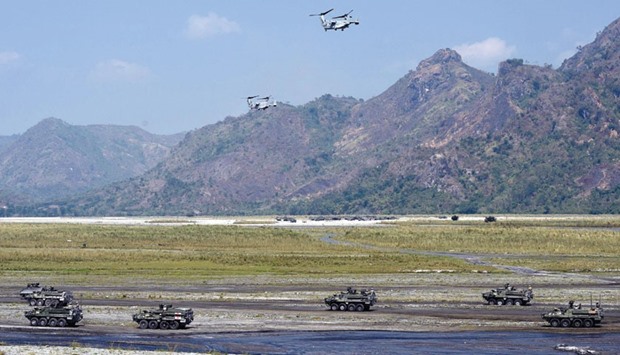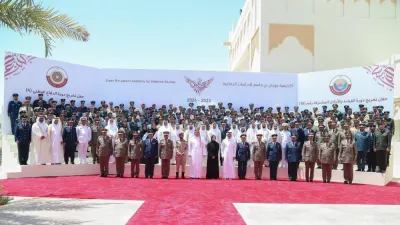
Two V-22 Osprey aircraft hover above Philippine and US marines during a live fire exercise as part of Balikatan joint US-Philippine military drills at Crow Valley.
The Philippines and the United States had started joint patrols in the West Philippine Sea (South China Sea) amid China’s increasing reclamation and militarisation activities in disputed waters.
Defence secretary Ashton Carter yesterday said the first joint patrol was carried out in March and the second was held in early April.
“Last month, we commenced joint maritime patrols in the South China Sea. These patrols will continue to help build our inter-operability and improve the Philippine Navy even as these patrols contribute to the safety and security of the region’s waters,” Carter told reporters after meeting with president Benigno Aquino 3rd in Malacanang.
He pointed out that China’s actions “are causing anxiety and raising regional tensions”.
The US, he noted, is standing by its allies and new partners, “affirming our commitment to their and the region’s security with increased posture”.
“We’re standing up for those rules and principles. We’re making important new defence in US defence technology. And we are continuing to fly, sail and operate wherever international law allows. And we always will,” Carter said.
“Nothing will deter us from defending our core interest in freedom of navigation and overflight,” he added.
Carter said hundreds of US troops and several ground attack aircraft brought in for the Balikatan (shoulder-to-shoulder) exercises will remain in the Philippines temporarily.
Also, about 200 US airmen from Pacific Air Forces units will stay until the end of the month, along with three HH-60G Pave Hawks, five A-10C Thunderbolt IIs and an MC-130H Combat Talon II.
In addition, up to 75 US military personnel will stay at Camp Aguinaldo, the Philippine military’s general headquarters located in Quezon City, to work on inter-operability between the two militaries and enhance joint command and control capabilities.
Carter, however, said the US military presence does not aim to provoke China but as a way of “tamping down tensions”.
The US, he added, is “on the side of peaceful resolution and lawful disposition” of the territorial disputes in the South China Sea.
“The American position is very clear, it’s been consistent for a long time, which is, these things should be settled peacefully and lawfully. We recognise there are these disputes that they go back in time, we don’t take sides in them per se. We are on the side of peaceful resolution, we are on the side of lawful disposition,” Carter said in a joint news briefing with defence secretary Voltaire Gazmin.
“We are strengthening our military role in the region, both unilaterally and through this wide range of partnerships and alliances we have. But that is not in order to provoke anything, it’s to continue to stand with the system of principles and peace and security that has kept, that has allowed this region to prosper for many decades,” he added.
The Pentagon chief pointed out that the cause of concern in the disputed sea is China’s “self-isolating behavior,” not the US.
“I just want to make it clear that’s a real phenomenon but the cause of that is Chinese behavior, not America. America’s policy continues to be one that’s valued on the principles of peaceful resolution of disputes, lawful settlement of things like territorial disputes in the South China Sea or anywhere else, freedom of navigation, freedom of commerce, these are all the things that the United States stands for,” he said.
“Now, countries that don’t stand for those things or don’t stand with those things are gonna end up isolating themselves. But that would be self-isolation not isolation by us,” Carter added.
Gazmin said he expects the US military presence “will deter uncalled for actions by the Chinese”.
“We expect the US forces to help us in our maritime domain awareness through exchange of information,” he added.
The Philippines has been a strategic partner of the US.
For decades, it hosted major American military bases at Subic Bay in Zambales province and Clark Air Base in Pampanga province.Carter said US-Philippines military activities are planned for a broad range of contingencies.
“Maritime activities, natural disasters, accidents, incidents, provocations in, and from the American point of view, our alliance covers all of Philippine territory. Article 4 of our Mutual Defense Agreement makes that quite clear and so our military, the military activities cover a wide range of contingencies,” he added.
“We have a plan [on military installations] and the EDCA [Enhanced Defense Cooperation Agreement] has been approved. We’re still trying to figure out exactly what we wanted to do to improve some of these former bases and places to better support the territorial defense objectives of the Philippines,” Lt Gen John Toolan told reporters at the sidelines of the live fire exercise and the firing of M142 High Mobility Artillery Rocket System (HIMARS) at Crow Valley in Tarlac province, north of Manila.
Toolan said that as an ally, the US is more than happy to share with the Philippines war material such as the HIMARS and the V-22 Osprey if the need arises.
The HIMARS is a light multiple rocket launcher mounted on a standard Army Medium Tactical Vehicle (MTV) truck frame.
It was the star in a simulated assault exercise by 5,500 US and Philippine soldiers, unleashing six missiles at distant targets from a dry riverbed three hours’ drive from Manila.
“We’re allies and as allies we need to work together and I think that we’ll be more happy to share,” Toolan said.


